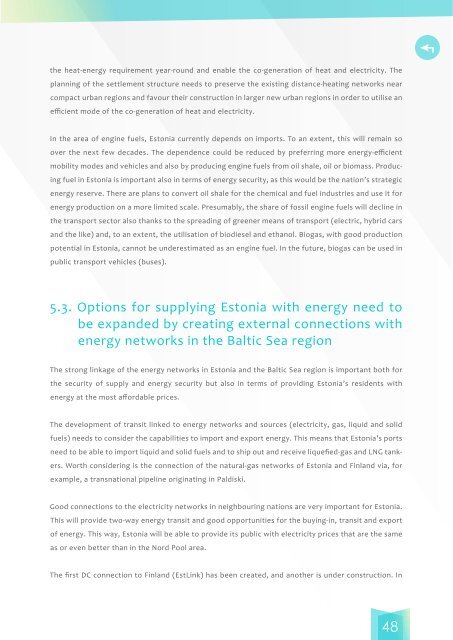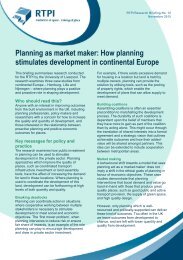estonia-2030_en
estonia-2030_en
estonia-2030_en
You also want an ePaper? Increase the reach of your titles
YUMPU automatically turns print PDFs into web optimized ePapers that Google loves.
the heat-<strong>en</strong>ergy requirem<strong>en</strong>t year-round and <strong>en</strong>able the co-g<strong>en</strong>eration of heat and electricity. Theplanning of the settlem<strong>en</strong>t structure needs to preserve the existing distance-heating networks nearcompact urban regions and favour their construction in larger new urban regions in order to utilise aneffici<strong>en</strong>t mode of the co-g<strong>en</strong>eration of heat and electricity.In the area of <strong>en</strong>gine fuels, Estonia curr<strong>en</strong>tly dep<strong>en</strong>ds on imports. To an ext<strong>en</strong>t, this will remain soover the next few decades. The dep<strong>en</strong>d<strong>en</strong>ce could be reduced by preferring more <strong>en</strong>ergy-effici<strong>en</strong>tmobility modes and vehicles and also by producing <strong>en</strong>gine fuels from oil shale, oil or biomass. Producingfuel in Estonia is important also in terms of <strong>en</strong>ergy security, as this would be the nation’s strategic<strong>en</strong>ergy reserve. There are plans to convert oil shale for the chemical and fuel industries and use it for<strong>en</strong>ergy production on a more limited scale. Presumably, the share of fossil <strong>en</strong>gine fuels will decline inthe transport sector also thanks to the spreading of gre<strong>en</strong>er means of transport (electric, hybrid carsand the like) and, to an ext<strong>en</strong>t, the utilisation of biodiesel and ethanol. Biogas, with good productionpot<strong>en</strong>tial in Estonia, cannot be underestimated as an <strong>en</strong>gine fuel. In the future, biogas can be used inpublic transport vehicles (buses).5.3. Options for supplying Estonia with <strong>en</strong>ergy need tobe expanded by creating external connections with<strong>en</strong>ergy networks in the Baltic Sea regionThe strong linkage of the <strong>en</strong>ergy networks in Estonia and the Baltic Sea region is important both forthe security of supply and <strong>en</strong>ergy security but also in terms of providing Estonia’s resid<strong>en</strong>ts with<strong>en</strong>ergy at the most affordable prices.The developm<strong>en</strong>t of transit linked to <strong>en</strong>ergy networks and sources (electricity, gas, liquid and solidfuels) needs to consider the capabilities to import and export <strong>en</strong>ergy. This means that Estonia’s portsneed to be able to import liquid and solid fuels and to ship out and receive liquefied-gas and LNG tankers.Worth considering is the connection of the natural-gas networks of Estonia and Finland via, forexample, a transnational pipeline originating in Paldiski.Good connections to the electricity networks in neighbouring nations are very important for Estonia.This will provide two-way <strong>en</strong>ergy transit and good opportunities for the buying-in, transit and exportof <strong>en</strong>ergy. This way, Estonia will be able to provide its public with electricity prices that are the sameas or ev<strong>en</strong> better than in the Nord Pool area.The first DC connection to Finland (EstLink) has be<strong>en</strong> created, and another is under construction. In48




